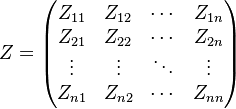Difference between revisions of "Input-Output Matrix"
Wiki admin (talk | contribs) |
Wiki admin (talk | contribs) |
||
| Line 22: | Line 22: | ||
* The matrix is a flow matrix, hence values refer to a particular time period. | * The matrix is a flow matrix, hence values refer to a particular time period. | ||
| − | === Multi- | + | === Multi-Regional Case === |
| + | In the case of a [[Multiregional Input-Output Model]] where industrial sectors operate within distinct "regions" (e.g., countries) the transactions matrix is most convinently expressed as a ''Tensor'' <math>Z^{pq}_{ij}</math> that captures exchanges between sector i and j located in regions p and q respectively. In practice this tensor is represented as a "rolled-out", [[Partitioned Matrix]]. | ||
== Usage == | == Usage == | ||
| Line 34: | Line 35: | ||
* [[Total Output]] | * [[Total Output]] | ||
| + | == Code == | ||
| + | * [https://github.com/konstantinstadler/pymrio pymrio]] | ||
== References == | == References == | ||
| Line 41: | Line 44: | ||
{{#set:Has Formula = HAS_FORMULA}} | {{#set:Has Formula = HAS_FORMULA}} | ||
| + | {{#set:Has Code = HAS_CODE}} | ||
__SHOWFACTBOX__ | __SHOWFACTBOX__ | ||
Revision as of 14:46, 2 March 2022
Contents
Definition
The Industry Transaction Matrix (o Transactions Table) is the fundamental quantitative information used in Input-Output Analysis. It concerns the flow of products from each industrial sector (considered as a producer) to each of the sectors, itself and others (considered as consumers).[1]
Formula
Single Region Case
Usually denoted as Z, if there are n sectors in an economy the matrix reads:
- The entries of the matrix may denote either monetary values (in some defined currency) or physical (activity) values, e.g. volumes.
- The matrix is a flow matrix, hence values refer to a particular time period.
Multi-Regional Case
In the case of a Multiregional Input-Output Model where industrial sectors operate within distinct "regions" (e.g., countries) the transactions matrix is most convinently expressed as a Tensor  that captures exchanges between sector i and j located in regions p and q respectively. In practice this tensor is represented as a "rolled-out", Partitioned Matrix.
that captures exchanges between sector i and j located in regions p and q respectively. In practice this tensor is represented as a "rolled-out", Partitioned Matrix.
Usage
This basic information from which an input-output model is developed is contained in an interindustry transactions table. The rows of such a table describe the distribution of a producer’s output throughout the economy. The columns describe the composition of inputs required by a particular industry to produce its output.
The Transaction Matrix is of fundamental importance and may underpin alternative possible input-output models.
See Also
Code
References
- ↑ R.E. Miller and P.D. Blair, Input-Output Analysis: Foundations and Extensions, Second Edition, Cambridge University Press, 2009
